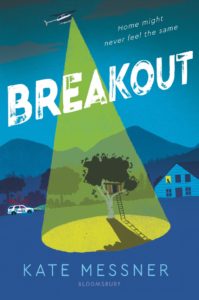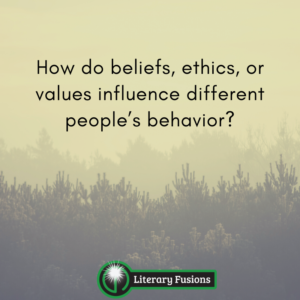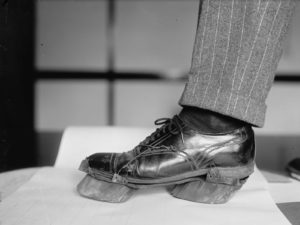Why I Picked It Up: Kate Messner. I’m a huge fan of anything she writes, so when Jessica told me about this one, I claimed it!
Why I Finished It: It was hard not to! First of all, the story is intriguing – a prison break in a small rural town in New York, and how that affects the citizens of that town, told from the perspective of three middle school girls. I went into it without any kind of expectation, except that I would enjoy it. Kate Messner definitely delivered a story that is not only engaging, but also deals with some pretty deep themes.
Secondly, I loved the method of storytelling in this book. It is told from multiple perspectives, which automatically gives it more depth, through multiple types of documents (letters, poems, text messages, news stories, and comics) that are to be included in the Wolf Creek Time Capsule. I enjoy reading these epistolary-type books, but I’ll admit, it was also a challenge. It definitely takes more brain power to piece together the story when it’s told this way! Messner does a masterful job of combining all the mediums to create her story, but you (the reader) do have to do your share to make it all come together.
Who I’d Give It To: Upper elementary or middle school students would enjoy this book. It’s a thick one, but don’t let that deter them! It’s a quick, but substantial read that kids will enjoy, but will also provide a variety of education opportunities upon which teachers can capitalize!
Integration Ideas
Theme – Diversity/Bias
How do beliefs, ethics, or values influence different people’s behavior?
This question is perfect to use with this story. Elidee Jones and her family are one of two black families that live in Wolf Creek. Additionally, one of the escaped inmates is also black. There are several times in the story where we see other people’s behavior towards them that is less than favorable: p 118 – 119, p 160-176, 193-202, p 275-278, p 321-326. Through the different entries, we get to see Elidee wrestle with how she and her family are treated, but we also see how Nora is processing what she’s witnessing and forming her own conclusions and beliefs.
There are other themes as well you could select – friendship/relationships, criminal justice, coming of age – it just depends on what you want to highlight in your classroom!
Text to Text Connections
Epistolary Style:
- Dying to Meet You (43 Old Cemetery Road Series), by Kate Klise – upper elementary novel
- Dracula, by Bram Stoker – “classic” novel
- Can I Be Your Dog? by Troy Cummings – picture book
Multiple Perspectives/Points of View:
- It Wasn’t Me, by Dana Alison Levy
- The Last Fifth Grade of Emerson Elementary, by Laura Shovan
- Because of Mr. Terrupt by Rob Buyea
- Nine, Ten: A September Eleven Story, by Nora Raleigh Baskin
- Wonderstruck, by Hugo Cabret
Research – Perspective and Evaluation Techniques
Nora notes early on in Breakout that in order to figure out what happened, “you have to look at all kinds of different documents and reports and interviews, and half the time, people say totally different things about what happened. So, you have to piece everything together to figure out the real deal.” I love this perspective on research! She’s talking about researching for writing a book on Alcatraz, but this applies in any kind of historical research, as well as in the book in which Nora is a character.
Use this facet of research to explore the issue of credibility. When we research, we’re trying to put together that bigger picture in order to answer questions about something that happened or is happening. We need more that one resource for precisely the reason that Nora points out – people interpret events differently. Ask students why they think that happens. Often it’s due to previous experiences, culture, bias, prejudice, etc. There are usually two (or more!) sides to every story, and it’s important that students realize that! The same way we want to help students relate to and understand the perspective of characters in a story that are all witnessing the same events, recognizing biases, the influence of previous experiences, etc, and how that colors their interpretation of the event, they can apply that same skill in evaluating the credibility of a source. Who wrote this? What is their background? What might this person gain from telling the story a certain way?
Here are some resources for showing multiple perspectives on current events:
- The Perspective is a website that shows two biased articles on the same issue.
- Review of Perspecs App that offers three articles from unique perspectives.
Here are some resources for evaluating “fake news” and other resources:
- Evaluating a News Article – Infographic from Easy Bib
- Research and Develop a Topic – Write Your Own Fake News– From Google Applied Digital Skills
Evaluation Strategies:
- E.S.C.A.P.E. Junk News – from NewseumEd
- C.R.A.P. Checklist – from Utah Education Network
- C.A.R.S. Checklist – from LiteracyTA
- 5Ws – Kathy Schrock
- Elementary School Checklist, Middle School Checklist, Secondary Checklist – Kathy Schrock
You can sometimes learn a lot about a situation from what is left out as well. Towards the end of Breakout (p 421), Elidee decides to contribute to the time capsule. She tells Nora that she didn’t want to be a part of the town’s story, but she realized that she was anyway. “It’s just a matter of who gets to tell my part of it.” Elidee decides to tell her own part of the story. How would the story have been different without her contributions? How would history be different without the input from certain people groups? Why is it important to get the WHOLE story? Is that possible? Take any major conflict in US or Texas history and see what it would have looked like without knowing the other side’s story or issues.
Fun side note: This (https://rarehistoricalphotos.com/cow-shoes-prohibition-1924/) plays into the story. I hadn’t heard of it until I read the book, and then a few weeks later, I ran across this picture! Primary sources for the win!
Poetry
An unlikely topic, you might think, for this story, based on what we’ve talked about so far. But Elidee is an aspiring writer, and many of her contributions to the time capsule are her poems that share her perspective of the events and her feelings/emotions/interpretations. Even just in her letter writing, her descriptions are very vivid and she often uses figurative language to help her brother (to whom she writes usually) be able to see what she sees. Page 31 is a great example of her ability to create the image of a place through her description using all five senses when she is describing her old home. Another example is on page 176: ” You know what it’s like hearing her prayers come into my room every night? They land on top of my blankets like bricks and I can barely breathe.”
What is really cool about Elidee’s process as a writer is that she has learned by reading. She talks about writer Jacqueline Woodson, who learned poetry by trying out other people’s styles, and that is what she does. Some of the pages from her notebook have titles on them that start with “Learning from…” Then, she records the original poem and her version. What a great opportunity to A) have students compare the two poems, B) have students do the same thing and emulate the original poem with their own content.
Elidee mentions or emulates several poets throughout the book:
- Gwendolyn Brooks – p 132
- Nikki Giovanni – 127
- Paul Laurence Dunbar – 135
- Nikki Grimes – 137
- Jacqueline Woodson – 139, 171, 220,222
- (there are more – this is just a start!)
She is also pretty obsessed with the musical Hamilton, which she saw with her class on Broadway before moving to Wolf Creek. Elidee skillfully parodies the songs from the musical a few times with her own words that pertain to her current events. This is a pop culture connection that would be fun to have students look into – finding the text of the original song from the musical and then comparing it to Elidee’s version. There are parallels between the events of the two versions that could start some interesting conversation. See one of her parodies on page 257 and another on 326, and 359-61 (there are more, these are a few to get you started).










Leave a Reply